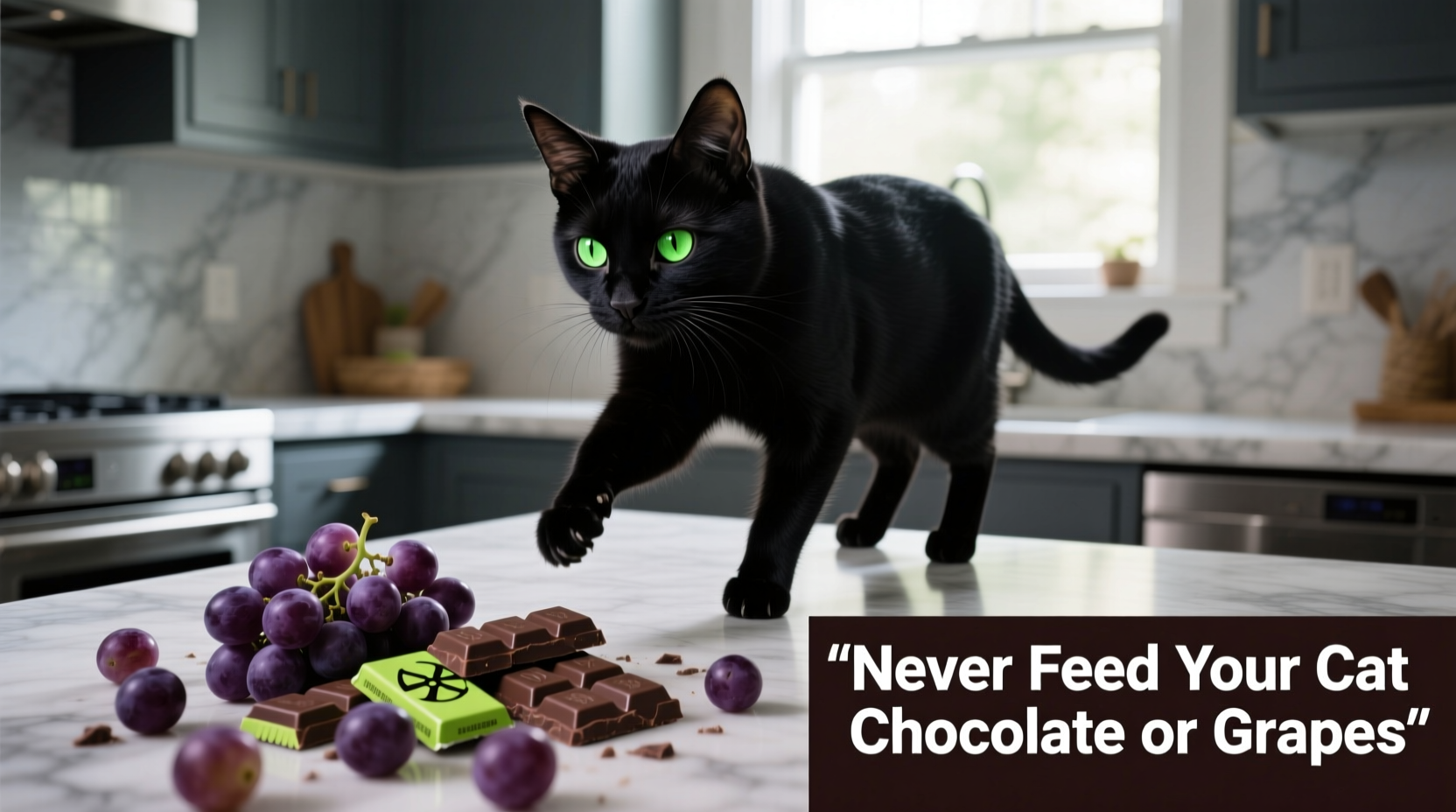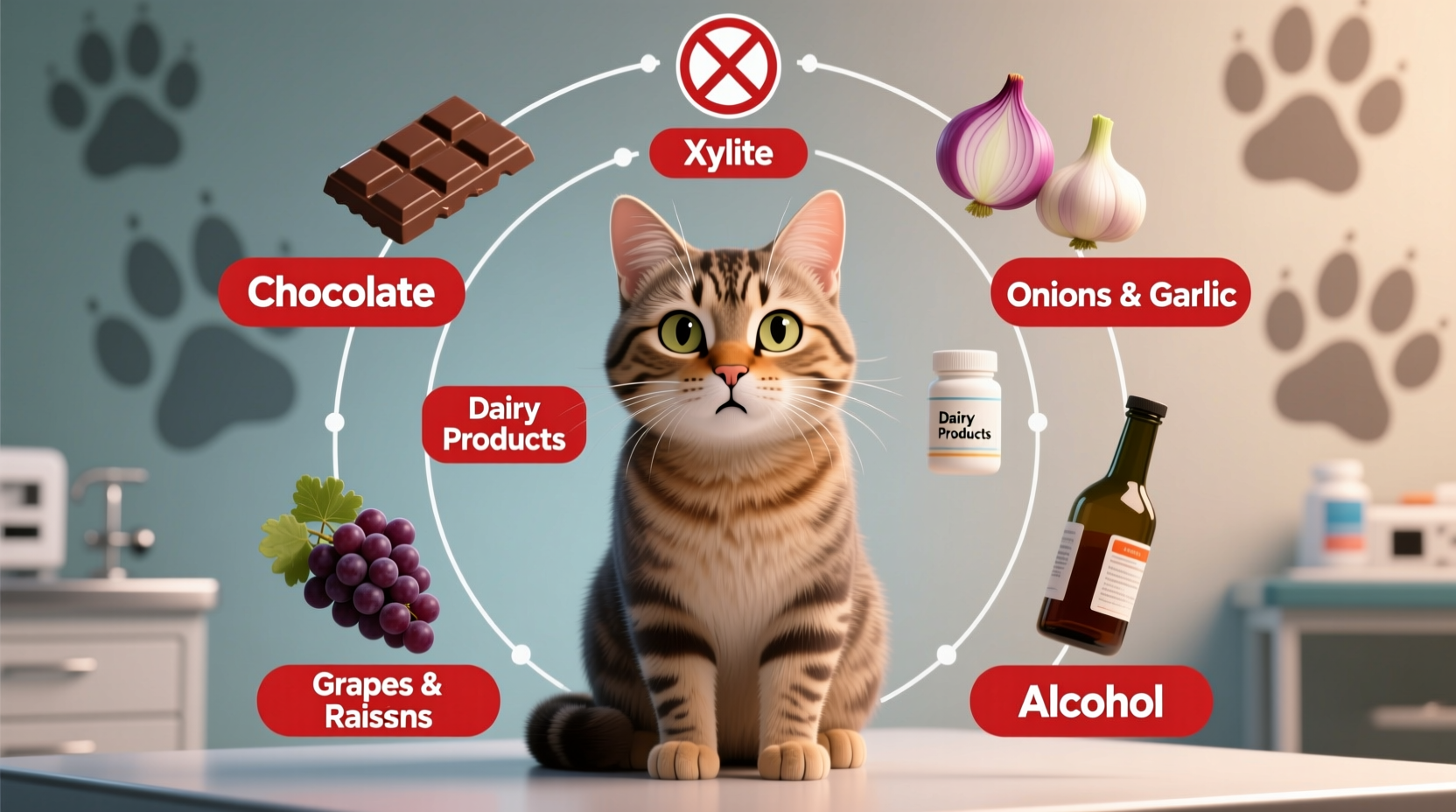Cats must never eat chocolate, onions, garlic, grapes, raisins, xylitol (artificial sweetener), alcohol, caffeine, raw dough, or cooked bones. These foods can cause kidney failure, anemia, seizures, or death. If your cat consumes any toxic food, contact your veterinarian or Pet Poison Helpline immediately at 800-213-6680.
Your kitchen contains hidden dangers for your feline companion. Unlike dogs, cats have unique metabolic pathways that make many common human foods potentially fatal. This comprehensive guide details exactly which foods cats cannot eat, why they're dangerous, and what to do if accidental ingestion occurs. You'll gain life-saving knowledge to protect your cat from household hazards that could cause organ failure or death within hours.
Why Human Foods Pose Unique Risks to Cats
Cats are obligate carnivores with specialized digestive systems. Their livers lack certain enzymes needed to process compounds found in human foods. For example, cats cannot metabolize N-propyl disulfide in onions and garlic, which destroys red blood cells causing hemolytic anemia. The ASPCA Animal Poison Control Center reports that food-related toxicities account for nearly 15% of all pet poisoning cases annually, with cats particularly vulnerable due to their smaller size and unique physiology.
| Toxic Food | Danger Level | Minimum Harmful Amount | Primary Organ Affected |
|---|---|---|---|
| Dark Chocolate | Extreme | 0.2 oz per pound of body weight | Heart & Nervous System |
| Xylitol | Extreme | 0.1g per kg body weight | Liver |
| Onions/Garlic | High | 5g per kg body weight | Blood |
| Grapes/Raisins | High | 3g per kg body weight | Kidneys |
| Alcohol | Extreme | 0.5ml per kg body weight | Nervous System |
Critical Danger Zone: Foods That Can Kill Within Hours
Chocolate and Caffeine
Chocolate contains theobromine and caffeine, which cats cannot metabolize. Just 0.2 ounces of dark chocolate per pound of body weight can cause seizures. Symptoms appear within 2-4 hours and include vomiting, rapid breathing, and cardiac arrhythmias. According to Cornell University's College of Veterinary Medicine, theobromine's half-life in cats is 75 hours compared to 6-10 hours in humans, making toxicity more severe and prolonged.
Xylitol: The Silent Killer in Sugar-Free Products
This artificial sweetener triggers insulin release in cats, causing hypoglycemia within 10-60 minutes. Found in sugar-free gum, peanut butter, and baked goods, xylitol can cause liver failure at doses as low as 0.1g/kg. The Pet Poison Helpline reports a 300% increase in xylitol cases since 2018 as sugar-free products become more common. Always check ingredient labels on peanut butter before sharing with pets.

Common Misconceptions About Cat-Safe Foods
Milk and Dairy Products
Despite popular belief, most adult cats are lactose intolerant. The American Veterinary Medical Association states that over 65% of cats lose the ability to digest lactose after weaning. While small amounts may not cause immediate harm, regular consumption leads to chronic diarrhea and digestive discomfort. Opt for specially formulated cat milk instead.
Dog Food as Emergency Substitute
Dog food lacks taurine, an essential amino acid cats must obtain through their diet. Cornell Feline Health Center warns that feeding dog food to cats for more than 24 hours can cause retinal degeneration and heart failure. Keep pet foods separated and store dog food in cat-inaccessible locations.
Emergency Response Protocol
If your cat ingests a toxic substance, follow these vet-recommended steps:
- Immediately remove remaining food and prevent further ingestion
- Call your veterinarian or Pet Poison Helpline (800-213-6680)
- Have packaging/food sample ready for identification
- Do NOT induce vomiting unless instructed (can worsen certain poisonings)
- Transport to emergency clinic with remaining substance
Time is critical - the ASPCA reports that cats treated within 2 hours of chocolate ingestion have a 95% survival rate, dropping to 60% after 6 hours. Keep emergency numbers programmed into your phone and visible near your home phone.
Safe Treat Alternatives and Prevention Strategies
Instead of risky human foods, offer these vet-approved alternatives:
- Cooked chicken or turkey (unseasoned, no bones)
- Small pieces of cooked fish (salmon, tuna)
- Commercial cat treats with single-ingredient formulas
- Cat grass for digestive health
Prevent accidents by implementing these safety measures:
- Store toxic foods in cat-proof containers
- Use covered trash cans with secure lids
- Train cats to avoid counters with double-sided tape
- Educate all household members about toxic foods
When Small Amounts Might Be Safe (With Caution)
While many human foods are toxic, some can be given in strict moderation:
- Cooked eggs: Small portions provide protein but must be fully cooked
- Cooked carrots: Only as occasional treats, finely chopped to prevent choking
- Plain cooked pumpkin: 1 teaspoon helps with hairballs but avoid canned pie filling
Always consult your veterinarian before introducing new foods. The American Association of Feline Practitioners emphasizes that cats have highly individualized tolerances - what's safe for one cat may harm another.
Frequently Asked Questions
Can cats eat small amounts of cheese?
While small amounts of hard cheeses like cheddar won't cause immediate harm to most cats, over 65% of adult cats are lactose intolerant. Cheese provides little nutritional value and can cause digestive upset. The American Veterinary Medical Association recommends avoiding dairy products entirely and choosing cat-specific treats instead.
What should I do if my cat eats a grape?
Contact your veterinarian immediately even if your cat ate just one grape. Grapes can cause acute kidney failure in cats, with symptoms appearing within 12 hours. Do not wait for symptoms to develop - early intervention with intravenous fluids significantly improves outcomes. Keep the Pet Poison Helpline number (800-213-6680) saved in your phone for emergencies.
Is tuna safe for cats as an occasional treat?
Small amounts of cooked, plain tuna are generally safe as rare treats, but should not exceed 10% of your cat's diet. The Cornell Feline Health Center warns that regular tuna consumption can lead to mercury poisoning and vitamin E deficiency. Never feed tuna packed in oil or seasoned varieties. Opt for commercial cat treats formulated with fish instead of making tuna a regular treat.
Why can't cats eat onions when dogs can?
Cats lack the enzyme glucuronyl transferase needed to break down N-propyl disulfide in onions and garlic. This compound causes oxidative damage to red blood cells, leading to hemolytic anemia. While dogs are also sensitive, cats are 2-3 times more vulnerable due to their smaller size and unique metabolism. The American Society for the Prevention of Cruelty to Animals states that as little as 5g of onion per kg of body weight can be toxic to cats.
How soon after eating chocolate will symptoms appear in cats?
Symptoms typically appear within 2-4 hours of chocolate ingestion, starting with vomiting and hyperactivity. Dark chocolate and baking chocolate are most dangerous due to higher theobromine content. The Cornell University College of Veterinary Medicine reports that theobromine's half-life in cats is approximately 75 hours, meaning symptoms can persist for days. Immediate veterinary care is crucial - survival rates drop significantly after 6 hours without treatment.











 浙公网安备
33010002000092号
浙公网安备
33010002000092号 浙B2-20120091-4
浙B2-20120091-4